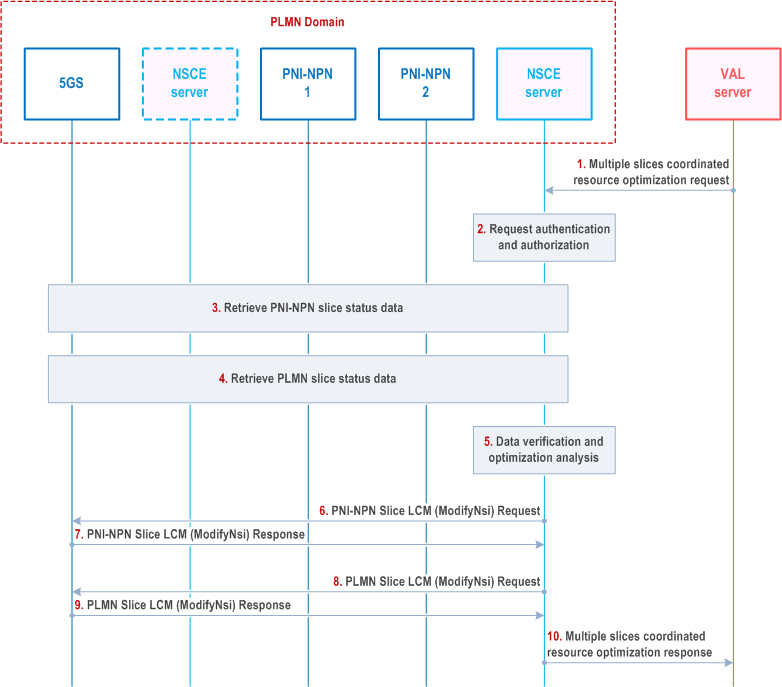Content for TS 23.435 Word version: 19.3.0
0…
4…
5…
7…
9…
9.4…
9.5…
9.6…
9.7…
9.8…
9.9…
9.10…
9.11…
9.12…
9.13…
9.14…
9.15…
9.16…
9.17…
9.18…
A…
9.10 Multiple slices coordinated resource optimization
9.10.1 General
9.10.2 Procedure
9.10.2.1 Procedure on multiple slices coordinated resource optimization
9.10.3 Information flows
9.10.4 APIs
9.10.4.1 General
9.10.4.2 SS_NSCE_MultiSlices_Optimization operation
...
...
9.10 Multiple slices coordinated resource optimization p. 73
9.10.1 General p. 73
Based on preferred QoS request from the vertical applications, the performance monitoring of multiple slices of one network (PNI-NPN slice and PLMN slice) and resource adjustment between different slices can be made to realize optimized and efficient resource usage.
9.10.2 Procedure p. 73
9.10.2.1 Procedure on multiple slices coordinated resource optimization p. 73
Figure 9.10.2.1-1 illustrates the procedure of multiple slices coordinated resource optimization service from VAL server to NSCE server.
Pre-conditions:
- The network slice enabler layer is capable to interact with PLMN 5GC or OAM system to handle slices of PLMN and its PNI-NPNs.
- PNI-NPNs are deployed as network slices of the PLMN.

Step 1.
The VAL server initiates multiple slices coordinated resource optimization request towards the NSCE server. The request includes VAL server ID, VAL service ID. The message also includes preferred optimization zone.
Step 2.
Upon receiving the request from the VAL server to make the network slice resource optimization, the NSCE server makes authentication and authorization of the VAL server and if VAL server is not authorized to send multiple slices coordinated resource optimization request, the NSCE server replies with failure response.
Step 3.
The NSCE server makes mapping from VAL service ID that received from VAL server to slice identities (S-NSSAIs allocated in multiple networks) and retrieves the network slice related status information from 5GC or OAM of PLMN for PNI-NPN slices, such as NF(s) load in 5GC and network utilization in access network as defined in TS 28.535.
Step 4.
The NSCE server retrieves the network slice related status information for PLMN from 5GC or OAM of PLMN networks for PLMN slices, such as NF(s) load in 5GC and network utilization in access network as defined in TS 28.535. The PLMN operator can choose to deploy NSCE-Server acting as single entry of PLMN capability exposure which can be optional.
Step 5.
The NSCE server verifies and analyses status data of network slices instance as well as network slice performance monitoring response (optional), then NSCE server makes resource optimization (e.g. shared radio resources, etc.) decision among different kinds of slices in specific location zone.
Step 6-7.
The NSCE server determines whether and what network slice LCM operations should be taken and makes the decision(s)/recommendation(s), such as modifyNsi request as specified in TS 28.531 to PNI-NPN slice. Based on decision made by NSCE server, the network slice management entity (such as NSMF) performs the corresponding operation(s) and sends LCM response including slice resource adjustment result.
Step 8-9.
The NSCE server determines whether and what network slice LCM operations should be taken and makes the decision(s)/recommendation(s), such as modifyNsi request as specified in TS 28.531 to PLMN slice. Based on decision made by NSCE server, the network slice management entity (such as NSMF) performs the corresponding operation(s) and sends LCM response including slice resource adjustment result. The PLMN operator can choose to deploy NSCE-S acting as single entry of PLMN capability exposure which can be optional.
Step 10.
The NSCE server sends the multiple slices coordinated resource optimization response towards VAL server.
9.10.3 Information flows p. 75
9.10.3.1 General p. 75
The following information flows are specified:
- Multiple slices coordinated resource optimization request and response.
9.10.3.2 Multiple slices coordinated resource optimization request p. 75
Table 9.10.3.2-1 describes information elements for the multiple slices coordinated resource optimization request from the VAL server to the NSCE server.
| Information element | Status | Description |
|---|---|---|
| Requestor Identifier | M | Unique identifier of the requestor (i.e. VAL server ID). |
| Security credentials | M | Security credentials resulting from a successful authorization. |
| VAL service identity | M | Identifier of the VAL service application to be monitored. |
| Optimization Zone | O | The preferred location area of the performance monitoring and optimization. |
| Requested S-NSSAI(s) | O | Indication of the S-NSSAI(s) which are requested. |
9.10.3.3 Multiple slices coordinated resource optimization response p. 75
Table 9.10.3.3-1 describes the information elements for the multiple slices coordinated resource optimization response from the NSCE server to the VAL server.
| Information element | Status | Description |
|---|---|---|
| Result | M | Indicates the success or failure of the multiple slices resource optimization request. |
| > VAL service identity | O
(see NOTE 1) | Identifier of the VAL service application to be monitored. |
| > Cause | O
(see NOTE 2) | Indicates the cause of multiple slices resource optimization request failure. |
|
NOTE 1:
Shall be present if the result is success and shall not be present otherwise.
NOTE 2:
Shall be present if the result is failure and shall not be present otherwise.
|
||
9.10.4 APIs p. 75
9.10.4.1 General p. 75
Table 9.10.4.1-1 illustrates the API for multiple slices coordinated resource optimization.
| API Name | API Operations | Known Consumer(s) | Communication Type |
|---|---|---|---|
| SS_NSCE_MultiSlices_Optimization | MultiSlices_Optimization | VAL server | Request /Response |
9.10.4.2 SS_NSCE_MultiSlices_Optimization operation p. 76
API operation name:
SS_NSCE_MultiSlices_Optimization_Request
Description:
The consumer subscribes for multiple slices coordinated resource optimization .
Inputs:
See clause 9.10.3.2.
Outputs:
See clause 9.10.3.3.
See clause 9.10.2 for details of usage of this operation.